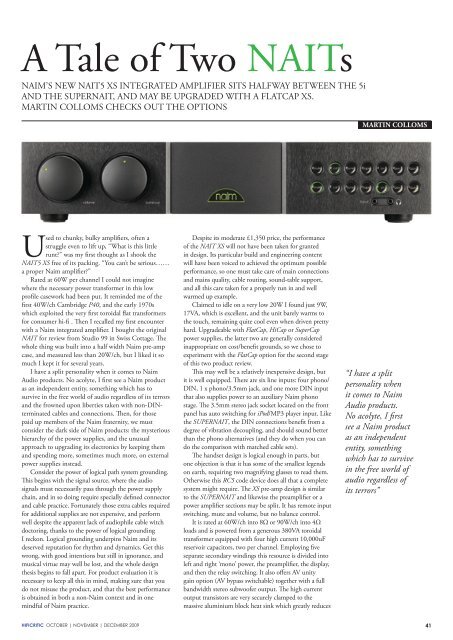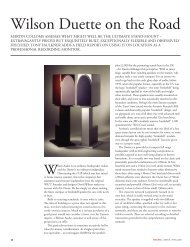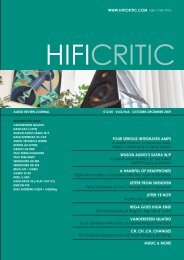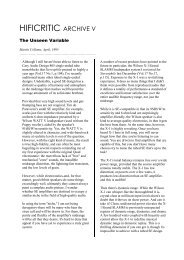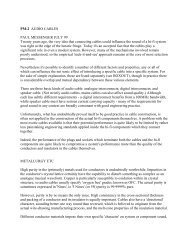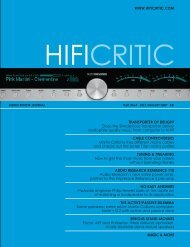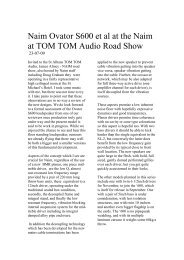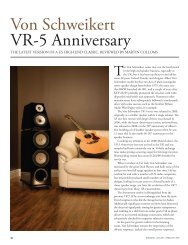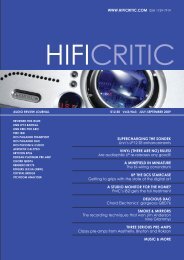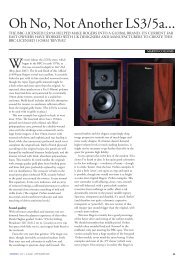HFC_issue16 5.indd - Hificritic.com
HFC_issue16 5.indd - Hificritic.com
HFC_issue16 5.indd - Hificritic.com
Create successful ePaper yourself
Turn your PDF publications into a flip-book with our unique Google optimized e-Paper software.
A Tale of Two NAITs<br />
NAIM’S NEW NAIT5 XS INTEGRATED AMPLIFIER SITS HALFWAY BETWEEN THE 5i<br />
AND THE SUPERNAIT, AND MAY BE UPGRADED WITH A FLATCAP XS.<br />
MARTIN COLLOMS CHECKS OUT THE OPTIONS<br />
MARTIN COLLOMS<br />
Used to chunky, bulky amplifiers, often a<br />
struggle even to lift up, “What is this little<br />
runt?” was my first thought as I shook the<br />
NAIT5 XS free of its packing. “You can’t be serious……<br />
a proper Naim amplifier?”<br />
Rated at 60W per channel I could not imagine<br />
where the necessary power transformer in this low<br />
profile casework had been put. It reminded me of the<br />
first 40W/ch Cambridge P40, and the early 1970s<br />
which exploited the very first toroidal flat transformers<br />
for consumer hi-fi . Then I recalled my first encounter<br />
with a Naim integrated amplifier. I bought the original<br />
NAIT for review from Studio 99 in Swiss Cottage. The<br />
whole thing was built into a half width Naim pre-amp<br />
case, and measured less than 20W/ch, but I liked it so<br />
much I kept it for several years.<br />
I have a split personality when it <strong>com</strong>es to Naim<br />
Audio products. No acolyte, I first see a Naim product<br />
as an independent entity, something which has to<br />
survive in the free world of audio regardless of its terrors<br />
and the frowned upon liberties taken with non-DINterminated<br />
cables and connections. Then, for those<br />
paid up members of the Naim fraternity, we must<br />
consider the dark side of Naim products: the mysterious<br />
hierarchy of the power supplies, and the unusual<br />
approach to upgrading its electronics by keeping them<br />
and spending more, sometimes much more, on external<br />
power supplies instead.<br />
Consider the power of logical path system grounding.<br />
This begins with the signal source, where the audio<br />
signals must necessarily pass through the power supply<br />
chain, and in so doing require specially defined connector<br />
and cable practice. Fortunately those extra cables required<br />
for additional supplies are not expensive, and perform<br />
well despite the apparent lack of audiophile cable witch<br />
doctoring, thanks to the power of logical grounding<br />
I reckon. Logical grounding underpins Naim and its<br />
deserved reputation for rhythm and dynamics. Get this<br />
wrong, with good intentions but still in ignorance, and<br />
musical virtue may well be lost, and the whole design<br />
thesis begins to fall apart. For product evaluation it is<br />
necessary to keep all this in mind, making sure that you<br />
do not misuse the product, and that the best performance<br />
is obtained in both a non-Naim context and in one<br />
mindful of Naim practice.<br />
Despite its moderate £1,350 price, the performance<br />
of the NAIT XS will not have been taken for granted<br />
in design. Its particular build and engineering content<br />
will have been voiced to achieved the optimum possible<br />
performance, so one must take care of main connections<br />
and mains quality, cable routing, sound-table support,<br />
and all this care taken for a properly run in and well<br />
warmed up example.<br />
Claimed to idle on a very low 20W I found just 9W,<br />
17VA, which is excellent, and the unit barely warms to<br />
the touch, remaining quite cool even when driven pretty<br />
hard. Upgradeable with FlatCap, HiCap or SuperCap<br />
power supplies, the latter two are generally considered<br />
inappropriate on cost/benefit grounds, so we chose to<br />
experiment with the FlatCap option for the second stage<br />
of this two product review.<br />
This may well be a relatively inexpensive design, but<br />
it is well equipped. There are six line inputs: four phono/<br />
DIN, 1 x phono/3.5mm jack, and one more DIN input<br />
that also supplies power to an auxiliary Naim phono<br />
stage. The 3.5mm stereo jack socket located on the front<br />
panel has auto switching for iPod/MP3 player input. Like<br />
the SUPERNAIT, the DIN connections benefit from a<br />
degree of vibration decoupling, and should sound better<br />
than the phono alternatives (and they do when you can<br />
do the <strong>com</strong>parison with matched cable sets).<br />
The handset design is logical enough in parts, but<br />
one objection is that it has some of the smallest legends<br />
on earth, requiring two magnifying glasses to read them.<br />
Otherwise this RC5 code device does all that a <strong>com</strong>plete<br />
system might require. The XS pre-amp design is similar<br />
to the SUPERNAIT and likewise the preamplifier or a<br />
power amplifier sections may be split. It has remote input<br />
switching, mute and volume, but no balance control.<br />
It is rated at 60W/ch into 8Ω or 90W/ch into 4Ω<br />
loads and is powered from a generous 380VA toroidal<br />
transformer equipped with four high current 10,000uF<br />
reservoir capacitors, two per channel. Employing five<br />
separate secondary windings this resource is divided into<br />
left and right ‘mono’ power, the preamplifier, the display,<br />
and then the relay switching. It also offers AV unity<br />
gain option (AV bypass switchable) together with a full<br />
bandwidth stereo subwoofer output. The high current<br />
output transistors are very securely clamped to the<br />
massive aluminium block heat sink which greatly reduces<br />
“I have a split<br />
personality when<br />
it <strong>com</strong>es to Naim<br />
Audio products.<br />
No acolyte, I first<br />
see a Naim product<br />
as an independent<br />
entity, something<br />
which has to survive<br />
in the free world of<br />
audio regardless of<br />
its terrors”<br />
HIFICRITIC OCTOBER | NOVEMBER | DECEMBER 2009 41
◆ REVIEW<br />
XS COMBINATIONS<br />
The £1,350 NAIT5 XS is just<br />
one <strong>com</strong>ponent in a series of<br />
cosmetically matching midprice<br />
XS-series products that<br />
represent a step up from the<br />
5i-series in performance and<br />
price. includes a CD5 XS CD<br />
player (£1,750), a NAT05 XS<br />
FM tuner (£995), a NAC152<br />
XS preamplifier (£895, but<br />
an external power source), a<br />
NAP155 XS power amplifier<br />
(£1,025), and also a FlatCap<br />
XS power supply (£675). The<br />
latter has two separate dual<br />
rail 24V supplies from a very<br />
generous 215VA toroidal<br />
transformer, and can power<br />
two separate XS products, or<br />
both outputs can be used to<br />
extract optimum performance<br />
from a NAC152XS pre-amp.<br />
An XS-series separates<br />
equivalent to this integrated<br />
NAIT5 XS could <strong>com</strong>prise<br />
a NAC152 XS preamplifier<br />
powered by and partnering<br />
a NAP155 XS power amplifier<br />
(£1925). Adding a FlatCap<br />
XS (taking the total price to<br />
£2,600) should give a sound<br />
quality superior but of similar<br />
character to the £2,050<br />
NAIT5 XS/FlatCap XS <strong>com</strong>bo<br />
described here. It’s easy to<br />
see why the inexpensive<br />
integrated NAIT5 XS has<br />
considerable mileage.<br />
short term temperature variations, in theory improving<br />
low frequency dynamics and focus.<br />
Speaker output is via paired 4mm sockets only, and is<br />
primarily intended for use with Naim’s two-pin plugs.<br />
The detachable IEC mains cable is adjacent to the rear<br />
panel power switch.<br />
Sound Quality<br />
NAIT5 XS<br />
I tried this amp on delivery. Although it had been used<br />
elsewhere, it had been disconnected for about a week.<br />
I ran it a day or so, did some listening, and thought it<br />
very good overall, hoping I’d got a reasonable measure<br />
of its performance. I then used it for two weeks and it<br />
progressively improved to a new plateau. While it would<br />
have deserved re<strong>com</strong>mended from the off, the subsequent<br />
improvement moved it into a higher class.<br />
Initially it sounded a bit two dimensional, cool in<br />
timbre, with slight treble grain, a touch of looseness in<br />
the lower bass, and some midrange forwardness. That<br />
said, it actually scored about 31, which is very good<br />
for the price, due to the good clarity, dynamics and<br />
rhythm. By week two (and with a magazine left on<br />
the top cover, as it runs very cool) it had reached an<br />
impressive 35 marks.<br />
While the bass was not as tight or deep as the<br />
SUPERNAIT (48 marks) or the Krell S300i, it still<br />
drove a good beat, and while textures were not so<br />
clearly revealed, it was faster, smoother, with deeper<br />
soundstages, better focus, cleaner treble and a more<br />
upbeat character than anything else I have experienced<br />
in this price sector. It was in the performance bracket<br />
of some of the best amplifiers at twice the price, with<br />
the proviso that its limit of 60W or so meant it would<br />
simply run out of peak headroom if volume was applied<br />
with too much enthusiasm.<br />
NAIT5 XS+FlatCap XS<br />
In reviews elsewhere I’ve seen reports that adding the<br />
FlatCap XS gave some but only a limited improvement.<br />
Maybe they simply stacked it on top? I gave it a shelf<br />
below the NAIT5 XS, properly routed all leads, and sat<br />
back to listen.<br />
The result was instant musical pleasure. While<br />
I really admired the standalone NAIT5 XS, finding<br />
Naim Nait XS 1W CCIF distortion spectrum 8ohm load<br />
its limitations minor, forgivable and relatively<br />
unimportant, this two-box variation kicked in<br />
with something special in its degree of intimacy. Its<br />
resolution, of image depth and focus, of bass detail<br />
and definition, and its upbeat ‘get up and go’ was way<br />
beyond its class. And it carried on getting better as it<br />
continued running in over another week.<br />
It simply sounded delightful: honest to the music,<br />
direct, un<strong>com</strong>plicated, and just got on with the job to a<br />
point where you simply forgot it was in the chain. Within<br />
its power envelope, this is a genuine ‘high end’ sound.<br />
No NAIT5 XS owner would argue with a 30% jump in<br />
sound quality to 45 points, and now knocking at the<br />
door of its big SUPERNAIT brother. (The SUPERNAIT<br />
still has better bass, sounds smoother and tighter though<br />
not more transparent, has 50% more power, and includes<br />
a more than <strong>com</strong>petent DAC. Furthermore, adding a Hi-<br />
Cap supply to power the SUPERNAIT’s pre-amp section<br />
boosted its score to a whopping 64 marks!)<br />
Lab Results<br />
The well sorted NAIT5 XS provided 2x 67W output for<br />
8ohm loads and about 71W peak program. Into 4ohms<br />
it provided 110W/ch, while music pulsed drive reaching<br />
172W into 2ohms, alongside a peak current of 13A. It<br />
will clearly cope with modern loudspeakers and rates as<br />
load tolerant. Output DC offset was low: 20/14.5mV<br />
for L/R respectively. Output impedance was also low,<br />
constant with frequency and close on 0.23ohm, so<br />
speaker impedances that vary with frequency will not be<br />
significantly affected.<br />
Input impedance is a kind 43kohm/145pF, and will<br />
sustain 6.5V before overload, a better than 20dB IHF<br />
margin. At full volume it needed just 125mV to get<br />
full power, so there’s more than enough gain. Channel<br />
separation ranged from 100dB at low frequencies to<br />
80dB midband and 63 dB by 20kHz, all very satisfactory.<br />
Channel balance was very good both with level and<br />
frequency, and was maintained at better than 0.3dB right<br />
down to a -60dB volume setting.<br />
Distortion was negligible (see graph for 10W<br />
20Hz-200kHz and matching frequency response). The<br />
spectrogram (fig 2 for 10W 1kHz) shows low noise<br />
and hum and nicely low levels of odd order harmonics.<br />
Distortion at 20kHz was around -68dB, midband about<br />
-80 dB, and it did not vary much with load impedance.<br />
Naim Nait XS frequency response<br />
10W 8ohm and distortion (green, dashed RHS)<br />
42 HIFICRITIC OCTOBER | NOVEMBER | DECEMBER 2009
◆ REVIEW<br />
The harmonics remained quite low order, with an almost<br />
monotonic progression from the second harmonic<br />
upwards, a favourable result. CCIF intermodulation<br />
performed well, recording an excellent -94dB product at<br />
10W 8ohms, and even measuring a low -86dB for the<br />
1kHz difference product at full power. Graph 3 shows the<br />
state of the art 1W result at -100dB, or just 0.001%.<br />
Signal-to-noise ratios were fine for rated output:<br />
93dB unweighted, 97dBA weighted, 86dB CCIR 1kHz,<br />
and there were essentially no hum products in the<br />
residuals, a great result. Frequency response was -0.3db<br />
at 10Hz, flat 20Hz-10kHz, and with a mild 1dB roll off<br />
by 20kHz. The response is tailored to -6dB by 50kHz,<br />
which is quite sensible in view of all the EMC muck<br />
generally flying around.<br />
I connected the FlatCap XS and laboured hard to<br />
measure a difference: indeed a taxing 80W/4ohm THD<br />
measurement gave identical results with and without<br />
the extra supply. Crosstalk distortion measurement<br />
under power actually gave a slightly poorer result for<br />
noise floor with the extra isolated supply, though there<br />
was an improvement of about 6dB in 150Hz harmonic<br />
breakthrough.<br />
Conclusions<br />
While we now have a pretty good idea how the<br />
consonant XS-series separates amplification will likely<br />
sound, we have two conclusions for what I regard as two<br />
distinctly identifiable integrated amplifiers.<br />
The standalone £1350 NAIT5 XS puts on a very<br />
fine show, delivering an excellent sound quality for its<br />
price and reaching well beyond its price class. It’s lively,<br />
upbeat, informative, detailed, quite clear, substantially<br />
accurate, and entertaining. It’s unfair to single out<br />
the softened lower bass and slight two dimensionality<br />
because the <strong>com</strong>petition is rather poorer in so many<br />
ways. The technical performance and build quality is<br />
beyond reproach and it is kind to sources and speakers.<br />
This is genuine high fidelity at a very <strong>com</strong>petitive price<br />
and may be highly re<strong>com</strong>mended.<br />
Add that c£700 FlatCap XS pre-amp supply,<br />
checking what standard Naim cables are supplied or<br />
needed, and one might at first wonder at the 50% extra<br />
cost. Wonder, however, ceases when you get to hear it.<br />
FlatCap XS delivers a cracking upgrade to the NAIT5<br />
Naim Nait XS 50W 1kHz crosstalk pectrum at about -110dB,<br />
8 ohm load; add Flatpack for red trace. (Case non proven)<br />
XS, and on grounds of sound quality alone effectively<br />
results in yet another amplifier model. Judging this at<br />
£2,000, it kicks in with a transparent high quality stereo<br />
image with depth and focus in spades, has quick and<br />
well defined bass, superior dynamics and a fine, upbeat<br />
and involving sound, with rhythmic capabilities streets<br />
ahead of the <strong>com</strong>mon herd. The technical performance<br />
specification remains unchanged. The sound quality<br />
here is now really chasing the SUPERNAIT’s tail.<br />
For sheer sound quality this supercharged NAIT5<br />
XS/FlatCap XS is another clean winner and is highly<br />
re<strong>com</strong>mended.<br />
INTEGRATED AMPLFIER TEST RESULTS<br />
Make _____________________________________________________________________________<br />
Naim Date 20/10/09<br />
Model _____________________________________________________________________________<br />
NAIT5 XS Ser. No. 268884<br />
POWER _____________________________________________________________________________<br />
OUTPUT 20Hz 1kHz 20kHz<br />
Continuous _____________________________________________________________________________<br />
8 ohm 2 channel 84 W 67 W 75 (1) W<br />
Continuous _____________________________________________________________________________<br />
4 ohm 1 channel 130 W 110 W 115 (2) W<br />
Pulsed _____________________________________________________________________________<br />
2 ohm 1 channel 172 W<br />
Output _____________________________________________________________________________<br />
impedance (ohms) 0.22 ohms 0.22 ohms 0.24 ohms<br />
Peak _____________________________________________________________________________<br />
Current<br />
13 A<br />
Distortion, _____________________________________________________________________________<br />
THD inc. noise (1W) -70 dB -80 dB -63 dB<br />
Distortion, _____________________________________________________________________________<br />
THD inc. noise (rated power) >-75 dB -75 dB -68 dB<br />
Channel _____________________________________________________________________________<br />
separation 100 dB 80 dB 63 dB<br />
Intermodulation _____________________________________________________________________________<br />
Distortion 19.5kHz/20.5kHz 1:1 rated power, 8 ohms<br />
-86 dB<br />
Intermodulation _____________________________________________________________________________<br />
Distortion 19.5kHz/20.5kHz 1:1 1W, 8 ohms -100 dB<br />
Signal _____________________________________________________________________________<br />
to noise ratio (ref. 60W output) CCIR Weighted Unweighted A-weighted<br />
IHF. _____________________________________________________________________________<br />
Aux 86 dB 93 dB 97 dB<br />
_____________________________________________________________________________<br />
Disc mm - dB - dB - dB<br />
_____________________________________________________________________________<br />
Disc mc - dB - dB - dB<br />
Channel _____________________________________________________________________________<br />
Balance over volume range<br />
R _____________________________________________________________________________<br />
ch is reference at 0dB 0 dB<br />
_____________________________________________________________________________<br />
at –20dB<br />
0.25 dB<br />
_____________________________________________________________________________<br />
at –40dB<br />
0.32 dB<br />
_____________________________________________________________________________<br />
at –60dB<br />
0.30 dB<br />
Frequency _____________________________________________________________________________<br />
Response: +0, -0.3dB 10 Hz to 10kHz, - 1dB at 20kHz, -6dB by 50kHz<br />
Absolute _____________________________________________________________________________<br />
Phase<br />
correct<br />
Input _____________________________________________________________________________<br />
Data Socket Sensitivity Loading<br />
Aux _____________________________________________________________________________<br />
input balanced - mV - ohms - nF<br />
Aux _____________________________________________________________________________<br />
input single ended (full power)<br />
_____________________________________________________________________________<br />
Phono or DIN 125 mV 43k ohms 145 pF<br />
Disc _____________________________________________________________________________<br />
mm Phono or DIN - mV - ohms nF<br />
Disc _____________________________________________________________________________<br />
mc Phono - uV ohms nF<br />
DC _____________________________________________________________________________<br />
offset Left 20 mV Right 14.5 mV<br />
Width _____________________________________________________________________________<br />
Height Depth<br />
Size _____________________________________________________________________________<br />
(w x h x d) 432 mm 70 mm 301 mm<br />
Price _____________________________________________________________________________<br />
£1,350 (FlatCap XS £675)<br />
Contact<br />
Tel: 01722 426600 www.naim-audio.<strong>com</strong><br />
Naim Nait XS 10W 1kHz distortion spectrum 8ohm load,<br />
low distortion. (Some balance of odd and even products)<br />
HIFICRITIC OCTOBER | NOVEMBER | DECEMBER 2009 43


